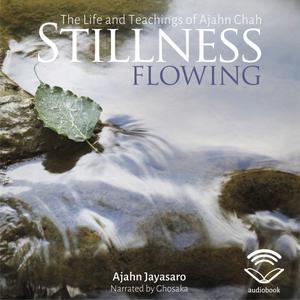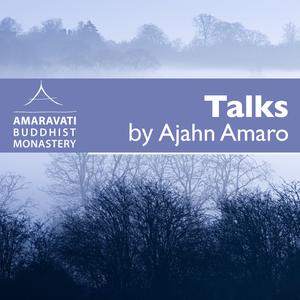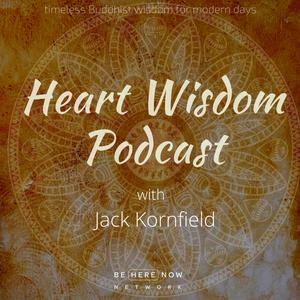
Stillness Flowing (audiobook)
Ajahn Jayasaro
The Life and Teachings of Ajahn Chah
- 5 minutes 52 seconds01 Chapter I: A Life Expired - A Death
The Death of Luangpor Chah: Part 1 A Death
The twentieth of January, 1983. At the small provincial airport of Ubon Ratchathani in Northeast Thailand, a group of Buddhist monks and lay supporters look up to the sky. Nearby, a white ambulance is parked on the runway. A loud droning sound can be heard, its source soon traced to a Thai Air Force plane lumbering in to land. After the plane taxies and comes to a halt, its door opens and reveals an unusual and moving sight. An imposingly large Western monk starts to descend from the plane, cradling in his arms a much older and smaller Thai monk. This frail and helpless-looking figure is the revered master, Luang Por Chah. After five long months of tests and consultations in a Bangkok hospital, he has returned to Ubon in order to spend the last days of his life at home in his monastery, Wat Nong Pah Pong, surrounded by his disciples.
…
15 January 2021, 6:46 pm - 27 minutes 1 second02 Chapter I: A Life Expired - A Cremation
The Death of Luangpor Chah: Part 2 A CREMATION
A winter afternoon in Ubon Province, Northeast Thailand, Saturday the sixteenth of January, 1993. A forest monastery, like a dark green patch upon a pale fabric of rice fields that stretch out fallow and dry. Tonight, it will be cold and windy, but in mid-afternoon the temperature in the shade of the gently swaying trees is 33 degrees. The calm and order of the scene belies a barely credible fact. Today, in an area usually inhabited by a hundred monastics, some four hundred thousand people are gathering – a number exceeding the population of any Thai city other than Bangkok. A year after the death of Luang Por Chah, it is the day of his cremation.
…
15 January 2021, 6:45 pm - 12 minutes 5 seconds03 Chapter II: A Life Inspired - A Suitable Locality
1918-1954: Part 1 A SUITABLE LOCALITY
The Buddha declared that all avoidable human suffering is caused by mental defilements, and that these defilements can be completely eliminated by a systematic education of body, speech and mind. Supreme among the virtuous qualities that ‘burn up’ the defilements, he revealed, is forbearance. It is perhaps no coincidence then that the unwelcoming environment of Northeast Thailand – known to its inhabitants as Isan – nurtured a great flowering of Buddhist monasticism in the twentieth century. The vast majority of monastics recognized in Thailand as enlightened masters over the past hundred years have come from this region.
…
15 January 2021, 6:44 pm - 1 hour 4 minutes04 Chapter II: A Life Inspired - Growing Up
1918-1954: Part 2 GROWING UP
Luang Por Chah was born on the seventh waning day of the seventh moon of the Year of the Horse, 1918. He was the fifth of eleven children born to Mah and Pim Chuangchot, who, like the vast majority of their generation, were subsistence rice farmers. The name ‘Chah’ means ‘clever, capable, resourceful’.
…
15 January 2021, 6:43 pm - 3 hours 8 minutes05 Chapter II: A Life Inspired - The Path of Practice
1918-1954: Part 3 THE PATH OF PRACTICE
‘Tudong’ is a Thai word derived from the Pali ‘dhutaṅga’, which means ‘to wear away’ and is the name given to the thirteen ascetic practices the Buddha permitted monks to undertake in order to intensify their efforts to wear away their defilements. In Thailand, the word has expanded in meaning. Monks who have left their monastery and are wandering through the countryside sleeping rough (usually practising a number of the dhutaṅga observances), are called ‘tudong monks’ and are said to be ‘on tudong’.
…
15 January 2021, 6:42 pm - 12 minutes 34 seconds06 Chapter II: A Life Inspired - New Directions
1918-1954: Part 4 NEW DIRECTIONS
In the hot season of 1952, Luang Por made his way to Ubon once more. He had been away for two years and his arrival in Bahn Kor caused a stir in the small village. In the evenings, he gave Dhamma talks of a power and persuasion that had never been heard before. This was a fresh, vital Buddhism, relevant to the villagers’ daily lives, expressed in language they could all understand. And yet it would be going too far to suggest his visit provoked revolutionary changes in the community’s spiritual life. The number of people that did not go to listen to him was probably larger than that of those that did. Indeed, some members of his own family were completely indifferent and remained so for many years afterwards. Everywhere in the world, it seems, old perceptions die hard. A common response, and one against which Luang Por would, in the future, wage a long struggle, was that what he said was true but beyond the capacity of ordinary people to live by. Be that as it may, Luang Por had already sowed a number of seeds in his home village. There was now a group of people, led by his mother, who hoped that, before too long, Luang Por would come back for good and establish a monastery in a forest not too far from Bahn Kor.
…
15 January 2021, 6:41 pm - 38 minutes 6 seconds07 Chapter III: Off the Beaten Track - Settlers
Wat Nong Pah Pong: Part 1 SETTLERS
It was on the eighth of March, 1954 that Luang Por Chah and his disciples made their way along the cart track running westwards from Bahn Kor on the last leg of their journey to Pong Forest. Afternoon temperatures at that time of year regularly exceed 35 degrees, but the oppressive heat would have cooled slightly as they approached the dense forest and the path become increasingly stippled and striped by the shade. In the late afternoon, as the gorged red sun was starting its descent ahead of them, the monks strung up their glots at the edge of the forest, amid the hum of mosquitos and the deafening shrill of cicadas.
…
15 January 2021, 6:40 pm - 54 minutes 45 seconds08 Chapter III: Off the Beaten Track - Golden Days
Wat Nong Pah Pong: Part 2 GOLDEN DAYS
The Luang Por Chah that left such an indelible impression on those who met him during his trips to the West in the mid-1970s is for many, the Luang Por Chah. Most of the surviving recorded talks, the well-known photographs, and the priceless seconds of footage in the BBC documentaries, were all from that period of his life. It is a wise, chuckling grandfather figure with a potbelly and walking stick that has embedded itself in the Western Buddhist pantheon. People who met him at that time recall a warmth and wisdom emanating from him that seemed timeless – so much so that it was hard for anyone to imagine that he could ever have been any other way. But, of course, he had. Looking back twenty years, a somewhat different Luang Por Chah emerges. At that time in his life, although he appears a powerful and impressive figure, he is also, perhaps, a less engaging one. If, in his later years, he might have been compared to an absolute monarch at ease in a peaceful kingdom, then in the 1950s, the comparison that would have come to mind was that of the warrior king of a troubled land.
…
15 January 2021, 6:39 pm - 6 minutes 11 seconds09 Chapter IV: A Life Inspiring - Introduction
Luang Por the Good Friend: Part 1 INTRODUCTION
From 1954 onwards, Luang Por Chah’s life was focused on his monastery, training the steadily growing number of monks, novices and nuns who were resident there, and teaching its lay supporters. By the late 1970s, he had become one of the most revered monks in Thailand. After travelling to England in 1977, however, Luang Por’s health started to decline. In early 1983, paralyzed and unable to express himself coherently, he stopped speaking. And in January 1992, after over nine years of stillness and silence, Luang Por’s life came to an end.
…
15 January 2021, 6:38 pm - 32 minutes 48 seconds10 Chapter IV: A Life Inspiring - Imponderables Anyway
Luang Por the Good Friend: Part 2 IMPONDERABLES ANYWAY
What exactly is meant by the ‘unshakeable deliverance of mind’? The Buddha taught that four stages of inner liberation may be discerned. Once attained, they cannot be weakened or lost, and hence they may all be deemed ‘unshakeable’. In fact, the word ‘attainment’ here has to be used with some caution. The Buddha defined each stage of liberation in terms of the irrevocable abandonment of specific mental defilements: a ‘deliverance’ from them. The changes that take place at each stage are thus experienced primarily in terms of endings rather than gains. In the central Buddhist metaphor, embodied in the word ‘Buddha’ itself, the experience is referred to as ‘awakening’.
…
15 January 2021, 6:37 pm - 46 minutes 25 seconds11 Chapter IV: A Life Inspiring - Sketches
Luang Por the Good Friend: Part 3 SKETCHES
A number of the qualities that came to define Luang Por in the eyes of his disciples were virtues held in universal regard. Perhaps the most prominent of these was that of patience. Although some accomplishments are necessarily private, the extent of a forest monk’s capacity to endure through physical discomfort and the rigours of monastic life can never be so. As the leader of a monastic community, Luang Por’s patience was visible to all. He earned the particular devotion of the monks of Wat Pah Pong by leading them from the front and by never asking them to do anything that he would not do himself. He also became renowned for his forbearance when dealing with the problems attendant on running a large monastery: listening to and advising on the difficulties and doubts of the monks and novices and maechees and lay supporters. When Luang Por spoke about patience – and he spoke about it often – his words carried great weight.
…
15 January 2021, 6:36 pm - More Episodes? Get the App
Your feedback is valuable to us. Should you encounter any bugs, glitches, lack of functionality or other problems, please email us on [email protected] or join Moon.FM Telegram Group where you can talk directly to the dev team who are happy to answer any queries.
 Ajahn Amaro Podcast by Amaravati
Ajahn Amaro Podcast by Amaravati
 Heart Wisdom with Jack Kornfield
Heart Wisdom with Jack Kornfield